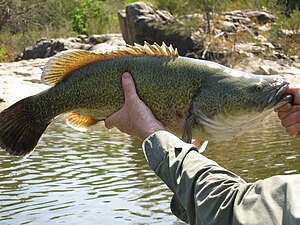Maccullochella peelii
| Maccullochella peelii | ||||||||||||
|---|---|---|---|---|---|---|---|---|---|---|---|---|

Maccullochella peelii |
||||||||||||
| Systematics | ||||||||||||
|
||||||||||||
| Scientific name | ||||||||||||
| Maccullochella peelii | ||||||||||||
| ( Mitchell , 1838) |

Maccullochella peelii is a freshwater Australian predatory fish of the genus Maccullochella from the family of codfish (Percichthyidae). It is one of the largest freshwater fish in Australia and iscalled the Murray Cod there. The species has an elongated body and a broad head and wasdescribedby Thomas Livingstone Mitchell in 1838.
The adult animals are carnivores and feed mainly on other fish. The eggs are laid by the females in sunken, hollow tree trunks or on other hard surfaces in spring. The parents care for the brood.
Fossils from strata that are up to 26 million years old are anatomically identical to recent specimens.
height and weight
In streams, the animals reach a size of 60 centimeters and a weight of three to four kilograms. In larger bodies of water they grow from 90 centimeters to one meter and weigh 35 to 45 kilograms. The largest fish ever officially measured was 183 centimeters tall and 113 kilograms, although there are unconfirmed claims of much larger specimens. However, with excessive sport fishing, the size of the average fish has decreased.
Other features
The fish has a large, elongated and broad-hulled body with a round cross-section, small eyes and short, dented teeth. The lower jaw protrudes slightly, especially in older specimens.
The basic color of the fish's body is yellowish-green to dark green with dark green, occasionally brown or black pitting. Depending on the clarity of the water, its color can change significantly. In addition, the color depends on the size of the animal. There are needle-like teeth in its large mouth. The large and rounded tail fins are dark gray to black and have white edges. The belly is white or cream in color.
distribution and habitat
The species is widespread in the Murray Darling Basin , originally in almost all watercourses in this system. Maccullochella peelii was a very common species in the past and one of the most common of the larger fish native to Australia.
Maccullochella peelii is a very adaptable species. Their habitat varies widely, from small streams to slow-flowing, often muddy rivers. Contrary to popular belief, Maccullochella peelii can be found not only in the deeper, but also in the mountainous regions of the Murray-Darling Basin.
decline
Today there are only a few specimens left, and wild populations have declined by more than 90 percent over the past 200 years. In many smaller rivers where the fish used to be widespread, it is now considered extinct.
The decline in the species is due to several factors. Contrary to popular belief, overfishing has played a massive role. The species was severely overfished by commercial fishermen in the second half of the nineteenth century. In 1883, more than 147 tons of the animal were put on the market. The amount actually caught was probably twice as high. Even sport fishermen have greatly reduced the stocks by excessive fishing during this time. Old photographs show how recreational anglers literally line up dozens of fish.
The only way to ensure the long-term survival of Maccullochella peelii is to establish healthy populations in the wild in healthy rivers with natural runoff.
Age
The fish is one of the longest lived freshwater fish in Australia, with longevity being characteristic of many freshwater fish in Australia. The oldest fish was 48 years old, but there have been even larger specimens in the past that could have been up to 70 years old.
Web links
swell
- Description on nativefish.asn.au. Retrieved January 28, 2012 .
- Description on environment.gov.au. Retrieved January 29, 2012 .
- IUCN Red List. Retrieved January 29, 2012 .
- Maccullochella peelii on Fishbase.org (English).

